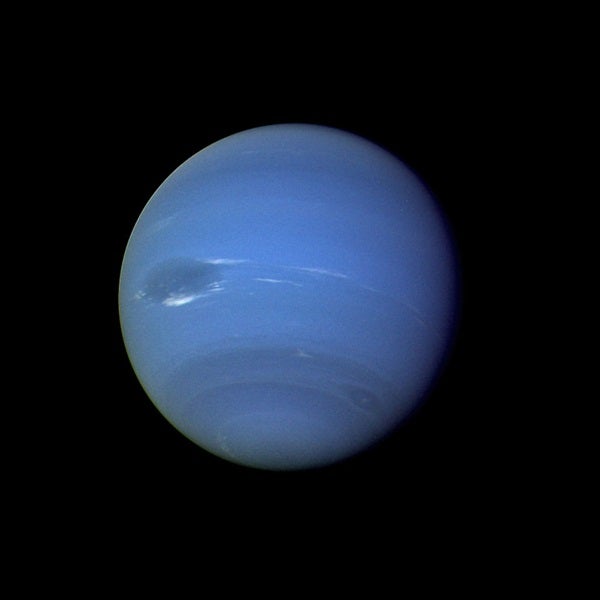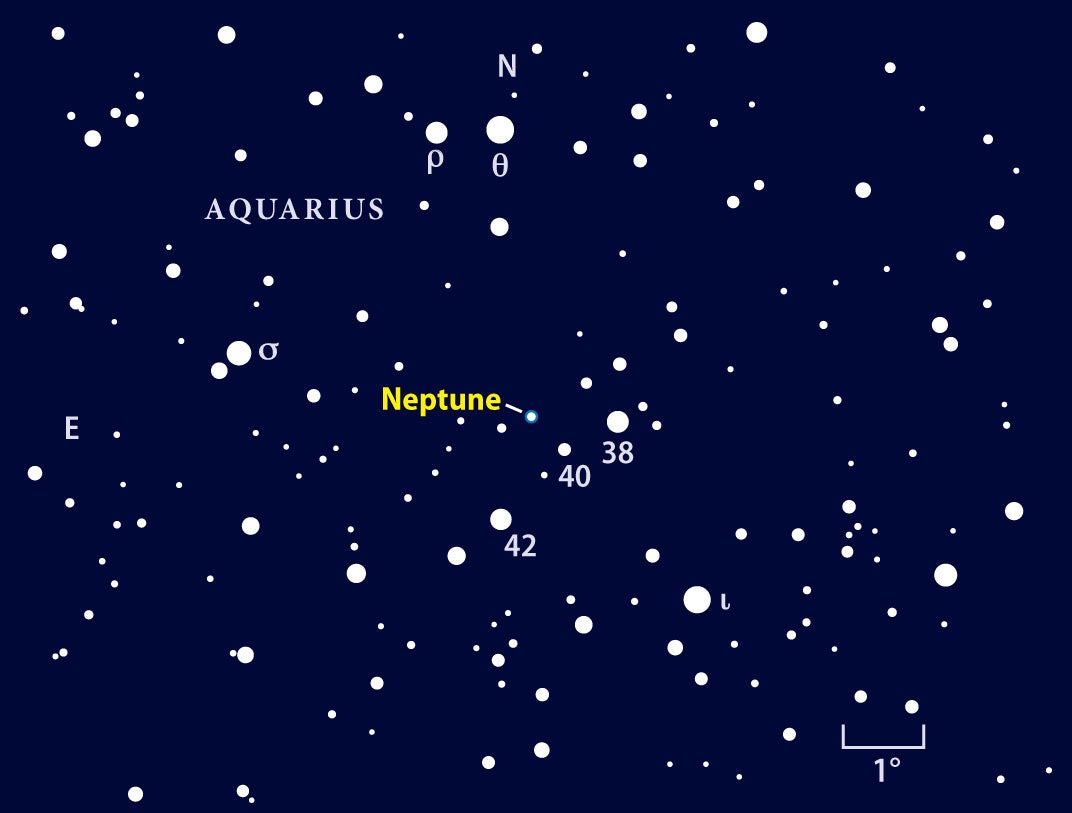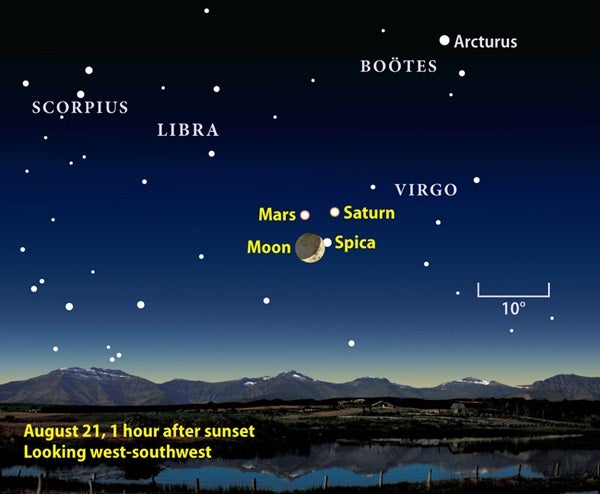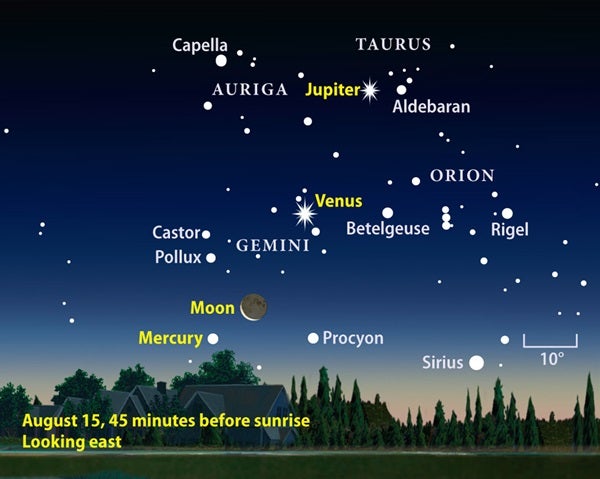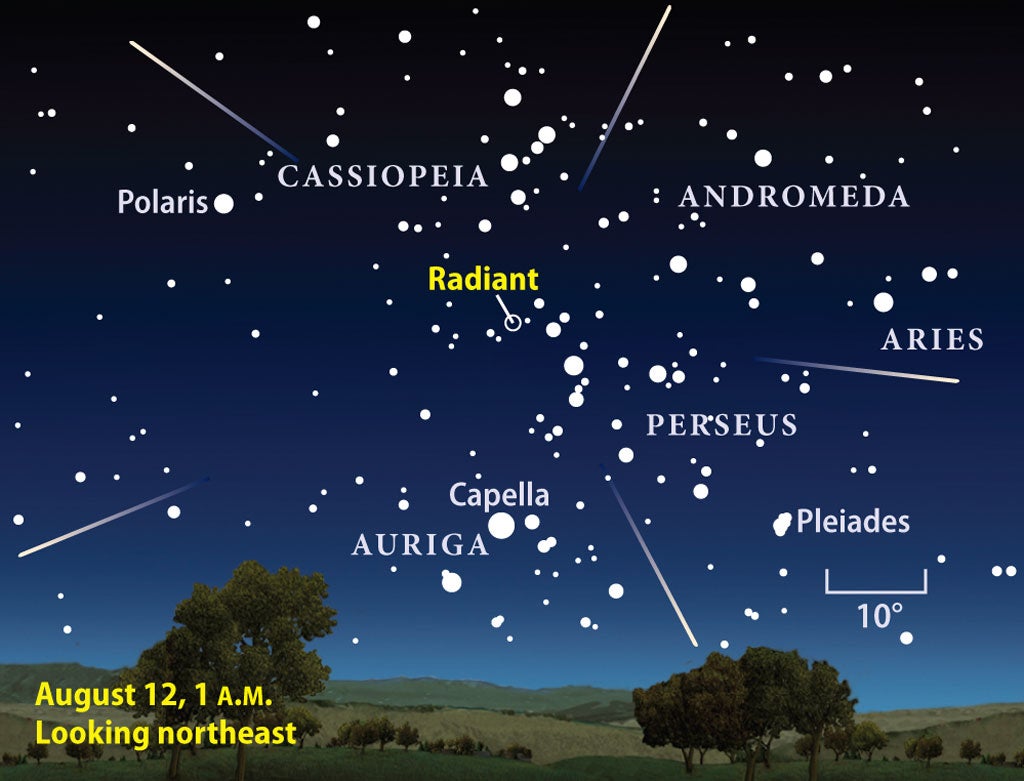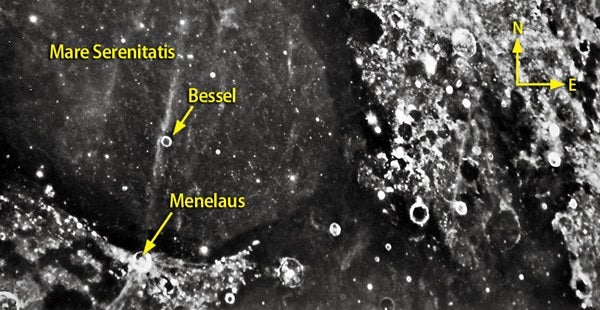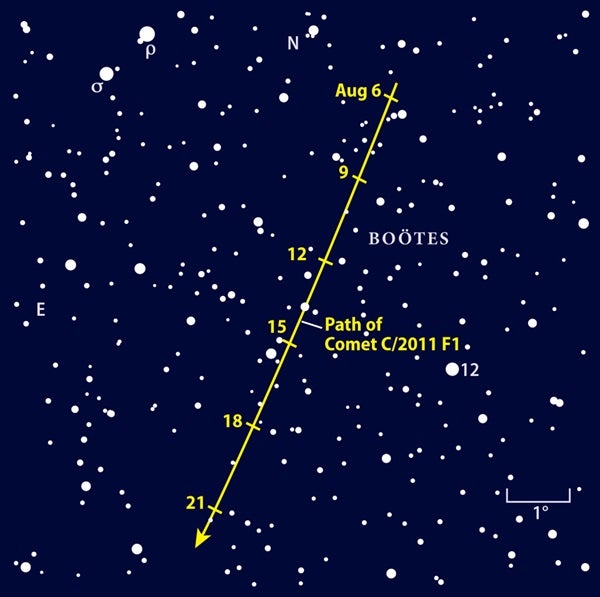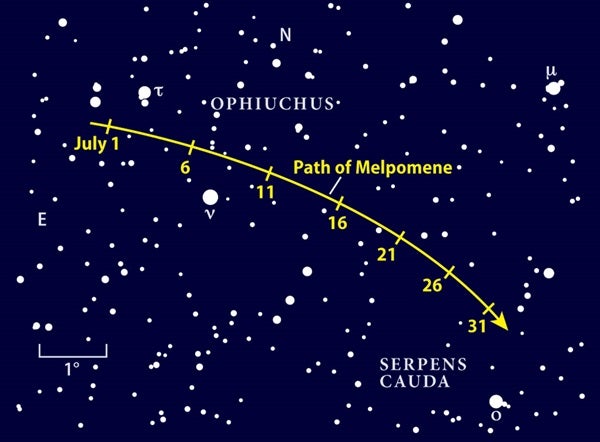A more brilliant spectacle adorns August mornings. Both Mercury and Venus lie farthest from the Sun and highest in the sky at midmonth. Jupiter completes the scene from its perch above the two inner planets.
Our planetary tour begins August 1 when three 1st-magnitude objects hang low in the southwest as the sky darkens. Saturn and Mars shine at magnitudes 0.8 and 1.1, respectively, and stand 8° apart. With each passing day, the two approach each other. Between August 7 and 20, they lie within a 5° circle that also includes magnitude 1.0 Spica. On the 7th, the three form a neat equilateral triangle 4° on a side.
Sunlight reflecting off Saturn’s cloud tops has a golden glow while Mars’ ruddy deserts cast an orange hue. They contrast with the hot sun Spica, a blue giant star that generates its own light from a surface seething at 22,000 kelvins — nearly four times hotter than the Sun.
If you could take a time-lapse movie of these objects during August, you would see Mars and Saturn sliding in front of Virgo’s stars. Mars, the closer of the two planets to the Sun, moves faster than distant Saturn. (The background stars remain stationary relative to each other.)
Consequently, Mars soon passes between Saturn and Spica. On August 13 and 14, the three form a nearly straight line. A week later, on August 21, the trio makes a second equilateral triangle (now with 5°-long sides) punctuated by a gorgeous crescent Moon hanging 4° below Mars. In the deepening twilight, the objects create a perfect scene for wide-angle photography. For the best shots, include some photogenic foreground trees or buildings.
When viewed through a telescope, Mars doesn’t offer much. Its tiny disk measures 5″ across, leaving everything to the imagination as it shimmers in the eyepiece. But the surface should come into sharp focus the night of August 5/6, the date NASA’s Curiosity rover is set to touch down on the Red Planet. For more information about the car-sized rover’s mission, see “Will Curiosity find life on Mars?” on page 20.
Although Saturn lies six times farther from Earth than Mars, the ringed planet looks far better through a telescope. That’s partly because its physical diameter is 18 times bigger than Mars’, so its apparent diameter is three times larger (16″). But even more important, Saturn has a beautiful ring system that spans 37″. The rings tilt 14° to our line of sight in mid-August, offering us a fine view of their northern face.
With Saturn now hanging low in the evening sky, most of its moons will be difficult to spot. But its biggest and brightest satellite remains on view
all month. Titan glows at 9th magnitude and takes 16 days to orbit Saturn. The moon appears closest to the planet when it passes either north or south of the globe. Look for Titan north of Saturn August 16 and south of it August 8 and 24.
Neptune reaches opposition August 24, when it lies opposite the Sun in our sky and remains visible all night. It also appears brightest at opposition (magnitude 7.8), but it changes so slowly that you won’t notice any difference during the month. And it’s still dim enough that you’ll need binoculars or a telescope to spot the distant world.
Neptune lies among the stars of Aquarius, in the same binocular field as 5th-magnitude 38 Aquarii. You’ll find the planet 1.7° east of the star August 1 and about half that distance by month’s end. This region doesn’t have many bright stars, so use the finder chart on page 36 to home in on the remote planet.
Scan farther east in the late-summer sky to pick up Uranus. It lies in the northwestern corner of Cetus the Whale, just over the border from Pisces the Fish. These constellations rise in the east around the time Mars and Saturn set in the west. Like Neptune, Uranus lies in a region devoid of bright stars. To find the right area, scan with binoculars a bit more than one-third of the way from 3rd-magnitude Algenib, the star at the southeastern corner of the Great Square of Pegasus, to 2nd-magnitude Beta (β) Ceti.
Uranus and its stellar neighbor, 44 Piscium, both glow at magnitude 5.8. Through binoculars, the planet-star combination will look like a wide double star. On August 1, Uranus lies 1.6° east-northeast of 44 Psc. The gap closes to 51′ (0.85°) by the 31st.
Larger binoculars (20×80, for example) or a telescope at low power will reveal a pleasing color contrast. The star shines at approximately the Sun’s temperature, so it has a yellowish hue, while the planet glows blue-green courtesy of atmospheric methane. Increase the power on Uranus to see its 3.6″-diameter disk. Although this planet is about the same physical size as Neptune, it appears 50 percent bigger because it lies two-thirds as far away.
The cavalcade of morning luminaries begins when Jupiter pokes above the horizon. This striking object rises shortly before 2 a.m. local daylight time August 1. Shining at magnitude –2.2, Jupiter lies 5° due north of 1st-magnitude Aldebaran, the red giant star that marks Taurus the Bull’s eye. A waning crescent Moon joins the pair August 11. The planet slowly crosses Taurus during August, ending the month in the middle of the Bull and rising shortly before midnight local daylight time.
Any telescope reveals Jupiter’s disk, which grows from 36″ to 39″ across during August. Even small instruments show plenty of atmospheric detail. Look for a series of bright zones alternating with darker belts that run parallel to the giant planet’s equator. Up to four bright moons join every scene. If you see fewer than four of these Galilean satellites, it means one or more of them is hiding in front of or behind the massive planet.
On the 1st, Venus stands 2° south of 3rd-magnitude Zeta (ζ) Tauri, the southern horn of the Bull. Between August 5 and 12, the planet crosses Orion the Hunter’s raised arm. A crescent Moon joins Venus on August 13, by which time the planet is tickling the feet of Gemini the Twins. Venus closes the month 9° south of 1st-magnitude Pollux, the Twins’ brightest star.
The period surrounding greatest elongation is always an exciting one for planetary observers. When viewed through a telescope this month, Venus shrinks and its phase waxes dramatically. Over August’s 31 days, its apparent diameter drops from 28″ to 20″ while its illuminated fraction grows from 42 to 58 percent.
Mercury comes to greatest western elongation a day after Venus. But at an angular distance of only 19° from the Sun, the innermost planet hugs the eastern horizon. Start looking for it around August 11. It then shines at magnitude 1.0 and rises about 80 minutes before sunrise. It quickly brightens, however, reaching magnitude –0.1 by greatest elongation August 16. That morning, it stands 10° above the horizon 30 minutes before the Sun rises.
Mercury grows brighter as the month progresses, partially offsetting its lower altitude. You should be able to track it until August’s final week, when it reaches magnitude –1.0 but lies only half as high in the predawn sky.
Mercury’s telescopic appearance changes at a much faster pace than Venus’. When it first comes into view August 8, the innermost planet spans 9″ and shows a 15-percent-lit phase. At greatest elongation, it displays a 7″-diameter disk that is 42 percent illuminated. And a week after that, Mercury appears 6″ across and 69 percent lit.
If weeknight observing leaves you tired and cranky, here’s some good news: One of this month’s premier events occurs Saturday night, August 11/12, when the Perseid meteor shower reaches its annual peak. Start observing around midnight local daylight time. Although a waning crescent Moon rises shortly after 1 a.m., it won’t have much impact because the shower consistently produces lots of bright, fast-moving meteors.
Observers under clear dark skies likely will see 60 to 80 meteors per hour streaking across a spectacular predawn sky that includes the bright planets Venus and Jupiter. Perseid meteors are tiny chunks of rock and dust from Comet 109P/Swift-Tuttle. When Earth plows through this debris stream each August, our planet’s atmosphere incinerates these particles.
You can double your chances to catch some lunar rays this month. Two Full Moons grace August’s sky, on the 1st and 31st. Although the second Full Moon in a calendar month has the popular nickname “Blue Moon,” the completely lit orb on the 31st will be anything but blue. Full Moons in summer lie low in the southern sky for observers at midnorthern latitudes, so they tend to appear more yellow than their wintertime white. Throw in some haze from high humidity or smoke from forest fires, and the Moon may look orange or even pink.
Many lunar observers consider the Full Moon’s most impressive feature to be the crater Tycho and its magnificent ray system. The rays are finely crushed particles that splashed out during the impact that formed Tycho. Your eye naturally follows the longest ray to the northeast, where it splits Mare Serenitatis (the Sea of Serenity) nearly in half.
The ray intersects Serenity’s southern shore at the bright circular crater Menelaus. This 17-mile-wide impact structure has sharp edges and a light-hued debris apron that is characteristic of relative youth. Next, follow Tycho’s ray northward into Mare Serenitatis, where it crosses the 10-mile-wide impact crater Bessel.
Now look carefully at the sea of ancient lava around these craters. Planetary scientists estimate that the darker shade is 3.8 billion years old. The lighter layer just to the north clocks in closer to 3 billion years. Can you see more white flecks — the telltale signs of tiny impact craters — in the darker, older zone?
Astronomers have learned that darkness usually equates with age on the Moon. Rays and debris aprons darken with time as energetic particles in the solar wind constantly blast the lunar surface.
| When to view the planets | ||
| EVENING SKY | MIDNIGHT | MORNING SKY |
| Mars (southwest) | Uranus (east) | Mercury (east) |
| Saturn (southwest) | Neptune (southeast) | Venus (east) |
| Neptune (east) | Jupiter (east) | |
| Uranus (southwest) | ||
| Neptune (southwest) | ||
Whether you’re breaking in a new telescope or reacquainting yourself with a dark sky at a summer star party, get ready to test your comet-hunting skills. This month’s brightest visitor from the solar system’s depths likely will be C/2011 F1 (LINEAR), which should glow feebly at 11th magnitude.
The comet floats above brilliant Arcturus in the western sky as night sets in. Wait until the Moon is out of the evening sky during the second and third weeks of August to hunt for LINEAR. Use the finder chart at right to zero in on the comet’s position. Rho (ρ) and Sigma (σ) Boötis, the pair of 4th-magnitude stars at the map’s top left, lie 12° north-northeast of Arcturus.
Using at least a 6-inch telescope, bump up the power past 100x to darken the background sky and make the comet’s small diffuse patch a bit bigger. Gently tapping the scope’s tube can help you pick up the ghostly glow because it brings your motion-sensitive averted vision into use. View the star chart with your non-observing eye to protect your dark adaption as much as possible.
If you’re still having trouble, ask an observer with a larger light bucket for a quick look. Sometimes after you see a faint fuzzy in a big scope, you can detect it in a smaller one — another benefit of attending a star party.
Meanwhile, the morning sky offers a comet that might reach 10th magnitude. If we’re lucky, Comet 185P/Petriew will experience an outburst similar to the one that allowed amateur astronomer Vance Petriew to discover it accidentally 11 years ago at the Saskatchewan Summer Star Party. This comet lies near the Crab Nebula (M1) in Taurus when it peaks in mid-August. Unless we get an unexpected visitor from the distant Oort Cloud, we won’t see any comets brighter than 10th magnitude before late winter.
The brightest asteroid on August evenings is 18 Melpomene. This 86-mile-wide space rock plies the southwestern section of Serpens Cauda, the tail of the Serpent, near that constellation’s border with Ophiuchus the Serpent-bearer. This region climbs highest in the south as darkness falls. Wait until the bright Moon leaves the evening sky around August 4 to track the magnitude 10.0 Melpomene.
Start your search at 2nd-magnitude Eta (η) Ophiuchi in the lower left corner of the Serpent-bearer. Then, shift a finder scope’s field of view to the east to your target. Melpomene remains within a couple of degrees of 4th-magnitude Omicron (ο) and Xi (ξ) Serpentis all month.
Note how the number of stars increases in the southern part of the field. With less obscuring gas and dust in this sector of the Milky Way, the distant lights shine through more easily. Of course, the higher star count also makes it harder to pinpoint the asteroid. Which point of light is it? You should be able to discern Melpomene from the pattern of stars on the finder chart. To be sure, plot the star field and label your suspect. Return to the same field a night or two later and confirm the asteroid by seeing which “star” moved.
Martin Ratcliffe provides professional planetarium development for Sky-Skan, Inc. Alister Ling is a meterologist for Environment Canada.

